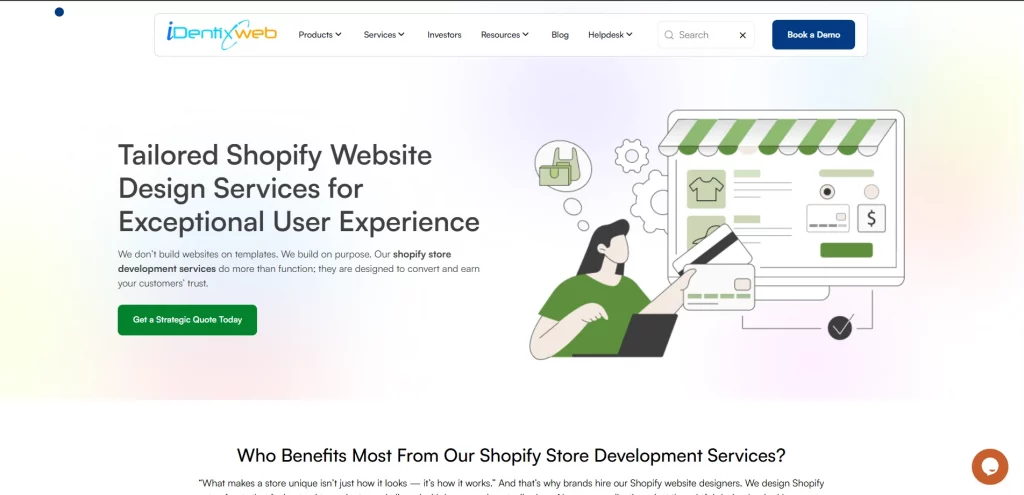
Are you ready to take your Shopify store to the next level? In today’s fast-paced ecommerce landscape, businesses need more than just a functional online store. They need flexibility, speed, and scalability to meet the ever-evolving demands of customers. This is where headless commerce solutions come in.
In this article, we’ll explore the basics of headless commerce, why Shopify merchants are adopting it, the key benefits it offers, step-by-step implementation, a cost breakdown, and why partnering with a Shopify headless commerce development expert is the smartest choice for scaling your store.
What is Headless Commerce?
Headless commerce separates the front-end (what customers see and interact with) from the back-end (where inventory, payments, and orders are managed). This gives merchants the freedom to move away from pre-built templates, allowing them to design custom storefronts that reflect their brand.
Unlike traditional ecommerce setups, where the front end and back end are tightly connected, headless commerce offers complete flexibility. Merchants can use tools, frameworks, and platforms like React, Vue.js, or Next.js to build unique shopping experiences, while still benefiting from Shopify’s reliable back-end for payments, inventory, and order management.
Key Benefits of Headless Commerce for Shopify
More Shopify merchants are embracing headless commerce solutions for the unmatched flexibility and growth potential they offer. Here’s why:
1. Unlimited Scalability
Headless commerce allows Shopify merchants to easily scale their stores to handle increased traffic and large product catalogs, especially during seasonal spikes or flash sales. The separation of the front and back ends ensures that your site remains stable, no matter how much traffic or volume it receives.
2. Creative Freedom
With headless commerce, you're no longer limited by Shopify's built-in themes. This freedom enables merchants to build fully customized, brand-centric designs that resonate with their target audience. You can tailor every aspect of the shopping experience, from layouts to interactive elements, without restrictions.
3. Faster Updates & Agility
The ability to update campaigns, content, and layouts independently of the back end makes headless commerce incredibly agile. Whether it’s launching a new marketing campaign or updating seasonal content, you can make changes quickly and efficiently without disrupting the underlying Shopify infrastructure.
4. Improved Site Speed & SEO
One of the biggest advantages of headless commerce is its performance optimization. By using modern frameworks for the front end, you can significantly improve your site’s load times, Core Web Vitals, and overall user experience. Faster sites lead to higher conversion rates and improved SEO rankings, helping you get noticed in search engines.
5. Omnichannel Flexibility
Headless commerce makes it easy to deliver consistent, seamless shopping experiences across multiple platforms, websites, mobile apps, social media, and even smart devices. The front end can be customized to meet the needs of each platform, while Shopify’s back end continues to handle payments, orders, and inventory.
This flexibility allows you to create a truly omnichannel experience that reaches customers wherever they are.
The cost of building a Shopify headless commerce store depends on complexity, tools, and the level of customization.
How Much Does It Cost to Implement Headless Commerce?
1. Development Costs
Building a headless Shopify store typically requires the expertise of skilled developers. Whether you choose to assemble an in-house team or collaborate with a development agency, here’s an overview of what you can expect in terms of costs:
| Expense Type | Estimated Cost Range |
| Front-End Development | $5,000 – $50,000+ |
| Back-End Integration | $3,000 – $15,000+ |
| API Setup | $1,000 – $10,000+ |
2. Tools & Platforms
| Tool/Service | Estimated Monthly Cost |
| CMS (e.g., Contentful) | $300 – $2,500+ |
| Hosting for Front-End | $50 – $500+ |
| Third-Party APIs | $100 – $1,000+ |
3. Maintenance & Updates
| Scope | Estimated Monthly Cost |
| Technical Support | $500 – $2,000+ |
| Performance Optimization | $1,000 – $5,000+ |
Several headless commerce platforms and headless commerce tools support Shopify merchants in making this transition:
Headless Commerce Tools & Platforms
- Shopify Headless Commerce API – Leverage Storefront API and GraphQL for maximum customization.
- Content Management Systems (CMS) – Tools like Contentful, Strapi, or Sanity help deliver rich content experiences.
- Front-end Frameworks – React, Vue.js, and Next.js are widely used for building high-performance front ends.
- Hosting Solutions – Platforms like Vercel and Netlify ensure global fast delivery.
Implementing headless commerce may sound complex, but with the right approach, it’s straightforward.
Steps to Implement Headless Commerce with Shopify
Step 1: Choose a Front-End Framework
React, Vue.js, or Next.js are popular for creating fast, dynamic storefronts.
Step 2: Connect Shopify APIs
Shopify’s Storefront API (GraphQL) allows the front end to fetch product, checkout, and order data seamlessly.
Step 3: Use a Headless CMS
Tools like Contentful, Strapi, or Sanity allow you to manage content independently for more control.
Step 4: Build & Customize the Front-End
Develop a fully branded experience without restrictions from pre-designed themes.
Step 5: Test & Launch
Run performance, compatibility, and UX tests before going live.
Step 6: Monitor & Improve
Track performance metrics and optimize continuously.
Let's explore some examples:
Shopify Headless Commerce Examples
Several big brands are already leveraging Shopify headless commerce:
- Allbirds – Uses a React-based front end for a clean, fast, and eco-conscious shopping experience.
- Gymshark – Switched to headless to handle high-traffic drops and global scalability.
- Staples Canada – Built a headless solution to integrate content and commerce seamlessly.
Let's explore next, choosing the right partner can significantly impact your Shopify headless commerce success. Here’s why Identixweb stands out as the ideal choice:
Why Choose Identixweb for Your Shopify Headless Commerce Journey?

Proven Shopify Expertise
With 8 years of experience building Shopify solutions, we bring a deep understanding of the platform’s capabilities and how to optimize it for your store’s needs.
Custom Front-End Development
We create bespoke designs tailored to your brand’s identity, ensuring your storefront is not only visually appealing but also provides an exceptional user experience.
Seamless API Integrations
Our expertise ensures a smooth connection between your Shopify back-end and the custom front end, allowing your store to run seamlessly and efficiently.
Performance-Driven Solutions
We deliver optimized solutions focused on speed, scalability, and global reach, ensuring your store performs flawlessly across different regions and devices.
Shopify Custom App Development
Whether you need custom apps for advanced functionality or integrations, we specialize in creating Shopify apps that enhance your store’s capabilities and streamline operations.
Continuous Support
Our commitment to ongoing maintenance, updates, and performance improvements ensures your store stays up-to-date and performs at its best as your business grows.
Conclusion: Shopify Store with Headless Commerce Solutions
Headless commerce is the smarter, more flexible way to grow your Shopify store. By decoupling the front end from the back end, merchants unlock scalability, creative freedom, speed, and omnichannel opportunities.
As Shopify experts, we recommend embracing headless commerce to future-proof your store, improve user experience, and scale effectively across various platforms. By leveraging this powerful strategy, your business can stay ahead in a competitive market.
If you’re ready to future-proof your store, now is the time to take action.
FAQs: Headless Commerce Solutions
1. What are the headless limitations of Shopify?
While Shopify's headless solution offers flexibility, it can be complex to implement and requires skilled developers. Customization can also involve higher upfront costs for development and ongoing maintenance.
2. How does Shopify headless work?
Shopify headless works by decoupling the front-end (user interface) from the back-end (Shopify’s infrastructure). This allows merchants to design unique storefronts while using Shopify’s powerful back-end for inventory, payments, and order management.
3. Is Shopify good for headless commerce?
Yes, Shopify is a solid choice for headless commerce, especially with its APIs (Storefront API, GraphQL) and tools like Hydrogen that facilitate headless setups for highly customizable storefronts.
4. What is the benefit of Shopify headless?
Shopify headless offers benefits like customizability, scalability, and speed. It allows merchants to build unique, branded experiences and integrate with multiple platforms while relying on Shopify's secure back-end for operations.
5. Do I need developers for Shopify headless?
Yes, Shopify headless typically requires experienced developers to integrate custom front-end frameworks (React, Vue.js, etc.) and APIs with Shopify’s back-end for a smooth, optimized solution.




![How to Help ChatGPT Discover Your Products? [Updated Methods] How to Help ChatGPT Discover Your Products? [Updated Methods]](https://www.identixweb.com/wp-content/uploads/2025/12/18-12-Thu-Blog-How-to-Make-Your-Shopify-Store-Appear-in-ChatGPT_-1.webp)
![How to Lock a Shopify Store With a Password? A Complete Guide [2026] How to Lock a Shopify Store With a Password? A Complete Guide [2026]](https://www.identixweb.com/wp-content/uploads/2025/12/18-12-Thu-Blog-How-to-Set-up-Markets-on-Shopify.webp)

About the author
Bhavesha Ghatode
Explore Content with Bhavesha, a passionate and dedicated technical content writer with a keen understanding of e-commerce trends. She is committed to sharing valuable insights, practical assets, and the latest trends that can help businesses thrive in a competitive environment.